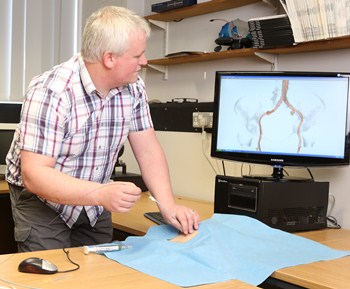Modelling
Graphics
Bangor University
Prof Nigel John, showing the results of some of the projects he led, during his 12 years at Bangor. Nigel is now continuing this work at the University of Chester.
The ‘Seldinger simulator’ combines two haptic devices: vessel puncture with a virtual needle and catheter and guide wire manipulation. The simulation software displays the instrument interactions with the vessels. Instruments are modelled using a mass-spring approximation, while efficient collision detection and collision response allow real time interactions.
Our needle insertion haptic device opens a new field of training through its accurate tracking of the needle while it is inserted in the vessel. This part of the Seldinger technique is a key component of the training of novice radiologists, as it can be challenging to locate the vessels in some cases and difficult to position the needle in a correct way to facilitate safe guide wire insertion.

Palpsim is a virtual environment for training femoral palpation and needle insertion - the opening steps of many interventional radiology procedures. Palpsim has been developed to allow trainees to feel a virtual patient using their own hands. The palpation step requires both force and tactile feedback. For the palpation haptics effect, two off-the-shelf force feedback devices have been linked together to provide a hybrid device that gives five degrees of force feedback. This is combined with a custom built hydraulic interface to provide a pulse like tactile effect. The needle interface is based on a modified PHANTOM Omni end effector that allows a real interventional radiology needle to be mounted and used during simulation.
